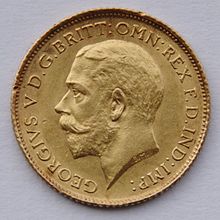Half sovereign
Half sovereign
This article needs additional citations for verification. (February 2010) (Learn how and when to remove this template message) |
United Kingdom | |
| Value | 1⁄2 pound sterling |
|---|---|
| Mass | 3.99 g |
| Diameter | 19.30 mm |
| Edge | Milled |
| Composition | 22 Carat Gold |
| Gold | .1176 troy oz |
| Years of minting | 1817 - Present |
| Obverse | |
 | |
| Design | Portrait of reigning monarch (George V obverse shown) |
| Reverse | |
 | |
| Design | Saint George and the Dragon |
| Designer | Benedetto Pistrucci |
The half sovereign is an English and later, British gold coin with a nominal value of half a pound sterling, or ten shillings. It is half the weight (and has half the gold content) of its counterpart 'full' sovereign coin.
Since the end of the gold standard, it has been issued only in limited quantities as a bullion or collectors' coin, with a sale price and resale value far in excess of its nominal value, though continues to be legal tender.
History[edit]
English coin[edit]
The half sovereign was first introduced in 1544 under Henry VIII. After 1604, the issue of half sovereigns, along with sovereigns, was discontinued.
British coin[edit]
In 1817, following a major revision of British coinage, new versions of half sovereigns and sovereigns were introduced.
Production continued until 1926 and, apart from special issues for coronation years, was not restarted until 1980.[1] It was also used extensively in Australia, until 1933.
Modern half sovereigns, from 1817 onwards, have a diameter of 19.30 mm, a thickness of c. 0.99 mm, a weight of 3.99 g, are made of 22 carat (91 2⁄3%) crown gold alloy, and contain 0.1176 troy ounces (3.6575 g) of gold. The reverse side, featuring St. George slaying a dragon was designed by Benedetto Pistrucci, whose initials appear to the right of the date.[2]
Mintages[edit]
| Year | Coins minted |
|---|---|
| 1982 | 2,500,000 |
| 1983–1999 | limited edition proofs only |
| 2000 | 146,822 |
| 2001 | 94,763 |
| 2002 | 61,347 |
| 2003 | 47,818 |
| 2004 | 34,924 |
| 2005 | 30,299 |
Counterfeiting[edit]
The half sovereign is a "protected coin" for the purposes of Part II of the Forgery and Counterfeiting Act 1981.[3]
See also[edit]
- Quarter sovereign - introduced in 2009
References[edit]
- ^ https://www.chards.co.uk/blog/half-sovereigns-information-page/277
- ^ https://www.ngccoin.com/price-guide/world/great-britain-1-2-sovereign-km-819-1911-1915-cuid-1129956-duid-1327263
- ^ The Forgery and Counterfeiting Act 1981, section 27(1), as read with the Forgery and Counterfeiting (Protected Coins) Order 1981 (S.I. 1981/505), article 2 and Schedule
External links[edit]
| Wikimedia Commons has media related to Half sovereign (British coin). |
- British Coins - Free information about British coins. Includes an online forum.
- Online Coin Club / Coins from United Kingdom / Half Sovereign (Pre-Decimal)
| Preceded by Unknown | Half Pound 1544–1926 | Succeeded by Ten shilling note |
| This coin-related article is a stub. You can help Wikipedia by expanding it. |

Comments
Post a Comment